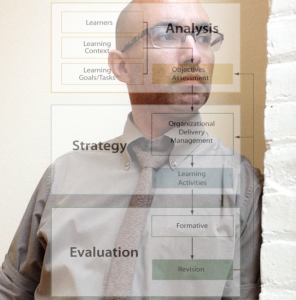Define Your Destination
If you don’t know where you are going, any road will get you there.
Lewis Carroll
(Alice in Wonderland)
Instructional system design begins with an analysis and this is a principle we can apply to more than just designing effective learning solutions. You can use these questions to define a plan of action to achieve your goals. It is futile to attempt solving a problem if we don’t know what the problem is. A good prescription comes as a result of a good diagnosis. We can’t suggest a solution without understanding the need first.Defined problems are easier to solve than undefined ones. The analysis phase is like detective work. We ask questions:
- Where are you now?
- Where do you want to go?
- What do you want to accomplish?
- Why? What is motivating you to go there?
- How do you get there?
The answers to these questions are going to help draw a roadmap. Imagine that you are using a GPS device. Identify your current situation. Define your destination. In order to determine the best route to take you need those two pieces of information. Certainly with no destination we can arrive anywhere. Leaving a trail of breadcrumbs in case you get lost is not effective. Just ‘ok’ is not enough. There are many more questions we can ask here depending on the situation in order to form a plan of action.
In the analysis we can’t forget about affective factors that are motivating the change. The attitude towards change can define the willingness to change and how much effort would be directed towards reaching the destination. Knowing where you are going is not enough. The affective domain includes values, beliefs, feelings and emotions. This is important to build a bridge between the current and the optimal desired situation because the affective domain gives ‘color’ to behavior by setting the mindset of the process.
The last question would be answer by synthesizing the answers from the previous questions. Once you have a map, the current and the desired destination, and the motivational factors, a plan of action can be designed. Through the process of designing the plan it is important to return to these questions and the answers and determine if necessary alternative routes as time and the plan progresses. Knowing where you want to go is a step to get there. You just have to start walking towards the vision you already have.


 While most people know me as an artist, I am also an instructional designer. In my research I contend that in order to provide effective learning solutions it is necessary to perform a learners analysis beyond the knowledge pre-assessment alone. Yes, understanding what people know before entering a specific learning endeavor is very important, but most important is to know the aptitudes and attitudes towards the new experience.
While most people know me as an artist, I am also an instructional designer. In my research I contend that in order to provide effective learning solutions it is necessary to perform a learners analysis beyond the knowledge pre-assessment alone. Yes, understanding what people know before entering a specific learning endeavor is very important, but most important is to know the aptitudes and attitudes towards the new experience.
Like Singing in the Shower
I began writing this blog two months ago because my wife suggested the idea. I didn’t know people actually read this stuff. I just began writing. To my surprise people are actually reading. I am very thankful for almost 10,000 views in two months to this website. I truly appreciate that. It is great to see the comments not only here but also in the social media sites. The e-mail messages are very encouraging and inspiring as well. I never received such good feedback from singing in the shower. I am sure that no matter how bad I write it is way better than my singing. Believe me when I say that you don’t want to hear me sing. It actually hurts people.
What’s the plan? What is this blog thing all about? This blog is a way to communicate the relationship between art, cognitive psychology, instructional design, and life. Which one is my favorite subject? I’ll say ‘experience’. I share what I live, know, and learn in these areas. I also like to write about all the things I don’t know. That makes it easier because I don’t know a lot. Like singing in the shower the plan is to enjoy the process of writing and do it from the heart, and sometimes from the brain. Since there is more hope for my writing than it is for my singing (no hope there) I would like to get better at it. It is a challenge to myself. By the one year milestone, for which I am not even close to almost halfway there, I would like to put together a book. Who knows? Maybe people still read books too.